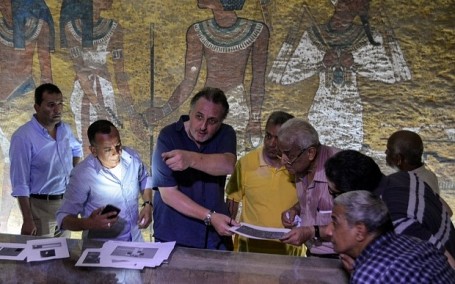On my most recent trip to visit my parents upstate, we watched the 2014 thriller The Pyramid. I will be honest, the movie was so bad it was close to causing me physical pain (predictable plot, etc., etc.,– I would need quite a long blog post to analyze all its inaccuracies), yet the film did manage to get one incredibly important factor correct—the thrill of the find. It reminded me of the great build up in the Indiana Jones movies—you’ve heard the myth of the object, you know it’s value (historically and monetarily) and then as you climb and swing through caves and dilapidated temples you see it glimmer out of the corner of your eye…

And yes, sometimes you grab it and it sets off a chain of events that lead to your almost-death, but sometimes you strike gold. The current thrill of Egyptology? The search for Queen (Pharaoh) Nefertiti’s tomb. During the past few months and excited buzz has spread across Egypt and throughout the rest world at the possibility of finding the lost queen of Akhenaten. Egyptologist Nicholas Reeves has come up with a theory that has rocked the world of Egyptology, and could lead to one of the biggest Egyptological discoveries of this century.

Reeves’s current investigations in the Tomb of Tutankhamun are based on the theory that the pharaoh Nefertiti is buried within a large chamber currently concealed behind a wall in the tomb of King Tut. Recent infrared scans of the tomb completed by Reeves’s team suggest that a chamber may indeed be hidden behind its walls. A team of scientists utilized infrared thermography to scan the wall, looking for changes in temperature in various sections that would allude to the presence of a separate chamber.

courtesy of Getty Images
Reeves suggests that Nefertiti was interred first, and that the entrance to her chamber was later plastered and painted over for the boy-king’s use. In an analysis of the tomb reliefs, a scene painted in Tut’s chamber depicts figures whose faces have physical features traditionally associated with portrayals of Nefertiti, including “a somewhat scooped brow and nose and a straight jawline with gently rounded chin.”[1] Reeves further cites the size and layout of the tomb as supporting evidence. With only four rooms, the tomb is considerable smaller than those of other pharaohs, suggesting that it may be part of a more expansive structure. Furthermore, anyone entering the chamber from the main corridor has to turn right, a tomb configuration traditionally reserved for Egyptian queens. When she died, Nefertiti would have been placed in an extravagant tomb, since as sole ruler she would be entitled to the more elaborate funerary paraphernalia of a pharaoh of Egypt. At the time of Nefertiti’s burial, there would have been no intention that Tutankhamun would, in due course, occupy the same tomb, but the unexpected death of Tutankhamun left the Egyptians unprepared, with no tomb yet dug for the young pharaoh. Reeves believes the ancient Egyptians selected their best option and utilized a tomb that was already built for a royal funerary purpose. [2]

courtesy of CNN
Nick Reeves has further found evidence that the famous mask of Tutankhamun was not intended for the boy-king, but for the pharaoh Nefertiti. When the mask was damaged and subsequently removed from display for conservation, a deeper analysis of the mask was possible for the first time since its discovery by Howard Carter. Reeves’s analysis brought to attention that near the cartouche identifying the mask as belonging to Tutankhamun, the remnants of the cartouche of Nefernefruaten remain, insinuating that the mask was intended first for Nefertiti and adding greater evidence to Reeves’s hypothesis of the hidden chamber within Tutankhamun’s tomb.
While many are ecstatic about the potential for this great of a discovery, Dr. Zahi Hawass, arguably the most famous Egyptologist of our time, believes that this hypothesis has no footing. Dr. Hawass said in a New York Times article “I can smell a discovery, and this is no discovery at all.” Hawass has said he will never allow an excavation to take place since it will involve the destruction of the walls of King Tut’s tomb, but Reeves and his team fight on. And wouldn’t we all? If there was even the slightest chance of finding that hidden, golden treasure? Wait…what’s that Indy? Look out for the boulder?!

Excellent job Melissa. Very interesting. Keep up the good work. I love reading your blog.